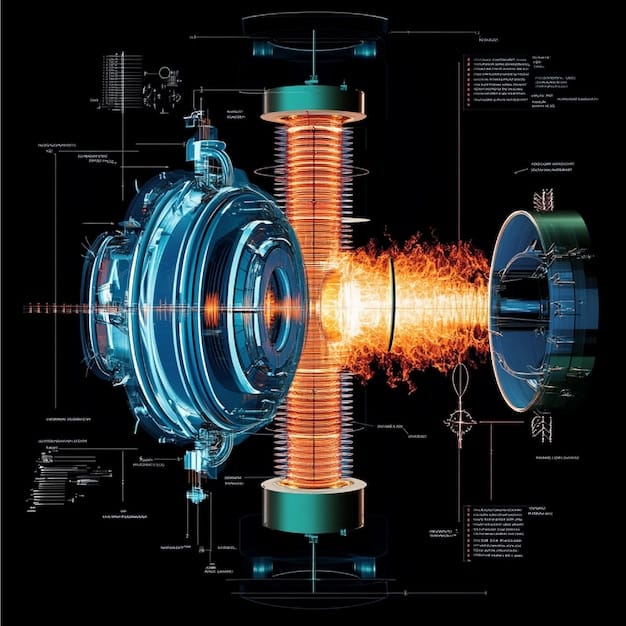US Military’s Hypersonic Weapon Development Program in 2025: An Update

The US military’s hypersonic weapon development program in 2025 is intensely focused on accelerating deployment, refining diverse missile systems, and solidifying a strategic advantage against peer competitors, reflecting an urgent prioritization of advanced capabilities.
In 2025, understanding what’s the latest on the US military’s hypersonic weapon development program is crucial for anyone monitoring global defense dynamics. This rapidly evolving field promises to redefine conventional warfare, and the United States is investing heavily to maintain a competitive edge. From groundbreaking tests to strategic partnerships, the journey toward operational hypersonic capabilities is fraught with technical hurdles and geopolitical considerations.
The Urgency of Hypersonic Superiority in 2025
The race for hypersonic superiority is not merely about technological advancement; it’s a critical component of national security and deterrence in an increasingly complex global landscape. By 2025, the imperative to fielding these weapons has intensified, driven by the rapid progress of potential adversaries and the strategic implications of their deployment. The US military perceives hypersonics as crucial for offsetting emerging threats and ensuring its ability to strike high-value targets with unprecedented speed and precision.
The Department of Defense (DoD) has articulated a clear strategy: develop, test, and deploy a range of hypersonic systems across all branches of the military. This multifaceted approach aims to address various operational needs, from long-range strike capabilities to tactical battlefield advantage. The push for faster development cycles is evident, with new testing protocols and collaborative efforts becoming standard practice to accelerate maturation.
Driving Factors Behind Accelerated Development
Several key factors are propelling the accelerated development of hypersonic weapons. These include the observed advancements by Russia and China, whose own programs have shown considerable progress. The ability of these potential adversaries to field such weapons necessitates a robust, responsive counter-capability by the United States to maintain strategic balance.
- Peer Competitor Advancement: Russia’s and China’s demonstrated capabilities spurred a renewed sense of urgency.
- Strategic Deterrence: Hypersonic weapons offer a formidable deterrent against potential aggressors due to their speed and maneuverability.
- Global Power Projection: The ability to conduct rapid, long-range strikes enhances the US’s global power projection capabilities.
- Technological Breakthroughs: Advances in materials science, propulsion, and guidance systems are making previously insurmountable challenges surmountable.
Moreover, the inherent advantages of hypersonic flight – including extreme speed, variable trajectory, and high maneuverability – make these weapons exceptionally difficult to detect, track, and intercept with current defense systems. This “game-changing” potential is why the US military is pouring significant resources into overcoming the remaining technical and operational challenges. The year 2025 represents a critical juncture in translating ambitious prototypes into reliable, deployable assets.
Key Programs and Prototypes Taking Shape
By 2025, various programs within the US military’s hypersonic development portfolio are progressing, each designed to meet specific needs of the Army, Navy, and Air Force. These initiatives reflect a diversified strategy, acknowledging that no single hypersonic system can fulfill all operational requirements. Collaboration between military branches, defense contractors, and research institutions is central to this effort, fostering innovation and sharing lessons learned.
The Army’s Long-Range Hypersonic Weapon (LRHW), known as ‘Dark Eagle,’ is a prominent example. It’s intended to provide ground-launched, conventional offensive strike capabilities against time-critical, high-value targets. The Navy mirrors this with its Conventional Prompt Strike (CPS) initiative, aiming to deploy similar capabilities from submarines and surface vessels, thus extending the reach of hypersonic deterrence across maritime domains. Both programs are leveraging a common glide body, streamlining development and reducing costs.
Air Force Initiatives and Beyond
The Air Force’s efforts are equally significant, focusing on air-launched hypersonic missiles. The AGM-183A Air-launched Rapid Response Weapon (ARRW) and Hypersonic Attack Cruise Missile (HACM) are at the forefront. While ARRW has faced its share of developmental challenges, HACM, a joint effort with Australia, shows promise for near-term deployment. These air-breathing cruise missiles are designed to complement boost-glide systems, offering different operational profiles and targeting options.
- ARMY: Long-Range Hypersonic Weapon (LRHW) ‘Dark Eagle’
- Goal: Conventional offensive strike capacity from land.
- Status: Continued testing and integration efforts in 2025.
- NAVY: Conventional Prompt Strike (CPS)
- Goal: Submarine and surface vessel-launched hypersonic strike.
- Status: Focused on integration onto Zumwalt-class destroyers and Virginia-class submarines.
- AIR FORCE: AGM-183A Air-launched Rapid Response Weapon (ARRW)
- Goal: Air-launched boost-glide capability.
- Status: Development challenges, but lessons learned are informing other programs.
- AIR FORCE: Hypersonic Attack Cruise Missile (HACM)
- Goal: Air-breathing hypersonic cruise missile for tactical strikes.
- Status: Promising joint development with Australia, targeting deployment in the late 2020s.
Each service component’s distinct focus underpins a comprehensive national strategy. These diverse systems ensure that the US military can respond to various threats and operate in multiple domains, solidifying its strategic advantage. Collaboration also extends to the commercial sector, where private companies are contributing specialized expertise in areas like advanced materials, propulsion, and complex systems engineering.
Testing and Evaluation Milestones in 2025
Testing and evaluation remain paramount in 2025, as the US military strives to validate the performance and reliability of its hypersonic weapon systems. These rigorous tests are essential for gathering critical data, identifying vulnerabilities, and refining designs before operational deployment. The ambitious schedules often face setbacks, but each test, regardless of its immediate outcome, provides invaluable insights for future development.
A series of flight tests are planned throughout 2025 for various prototypes. These tests often involve launching missiles from different platforms – air, land, and sea – to simulate diverse operational scenarios. The focus extends beyond successful launches to analyzing flight trajectories, aerodynamic performance, guidance system accuracy, and the ability of the weapon components to withstand extreme heat and pressure.

Challenges and Learnings from Testing
Hypersonic flight presents unique challenges, particularly concerning thermal management and maneuverability at extreme speeds. Materials must withstand temperatures reaching thousands of degrees Fahrenheit, and navigation systems must perform flawlessly in highly dynamic environments where traditional GPS signals can be unreliable. Every flight test contributes to understanding these complex interactions and engineering more resilient systems.
- Thermal Management: Developing materials and designs to withstand extreme heat during atmospheric re-entry and sustained flight.
- Guidance Accuracy: Ensuring precise navigation and targeting capabilities at hypersonic speeds, often in GPS-denied environments.
- Propulsion System Reliability: Perfecting scramjet engines and solid rocket boosters for consistent and efficient operation.
- Launch Adaptability: Verifying system compatibility and functionality across various launch platforms (air, sea, land).
Failures in testing, while frustrating, are viewed as learning opportunities that drive innovation and refinement. They provide critical data that cannot be replicated in simulation, pushing engineers and scientists to overcome existing limitations. The iterative nature of this development process means that preliminary test results are quickly integrated into subsequent design modifications, ensuring continuous improvement. The data gathered in 2025 will be pivotal for moving these programs from experimental phases to production.
Technological Innovations Fueling Hypersonic Progress
The advancements in the US military’s hypersonic program by 2025 are heavily reliant on groundbreaking technological innovations. These breakthroughs span various disciplines, from advanced materials science to sophisticated computational modeling, collectively pushing the boundaries of what’s possible in high-speed flight. Without these underlying scientific and engineering achievements, many of the challenges associated with hypersonic weapon development would remain insurmountable.
One of the most critical areas is materials science. Hypersonic vehicles experience extreme aerodynamic heating, necessitating new high-temperature alloys and ceramic matrix composites (CMCs) capable of maintaining structural integrity at blistering speeds and temperatures. Research in nanostructured materials and active cooling systems is also playing a significant role in mitigating thermal loads and enhancing durability.
Propulsion and Guidance Evolution
Propulsion systems are another frontier of innovation. Scramjet engines, which are air-breathing jet engines that operate at supersonic speeds (Mach 5 and above), are essential for sustained hypersonic cruise. Significant progress in scramjet design, ignition, and fuel efficiency is visible by 2025. Similarly, advances in solid rocket motors provide the initial boost for boost-glide vehicles, requiring high thrust and endurance.
- Advanced Materials: Development of high-temperature alloys, ceramic matrix composites (CMCs), and active cooling systems capable of withstanding extreme thermal stress.
- Scramjet Propulsion: Refinement of air-breathing scramjet engines for sustained, efficient hypersonic flight.
- Autonomous Guidance Systems: Integration of advanced inertial navigation and AI-driven guidance to ensure precision in challenging environments.
- Computational Fluid Dynamics (CFD): Use of supercomputing to model and predict aerodynamic performance, reducing the need for costly physical tests.
Guidance and control systems have also seen substantial evolution. Given the speeds involved, traditional navigation methods are often inadequate. Therefore, the US military is investing in advanced inertial navigation systems (INS), satellite-based navigation that resists jamming, and potentially AI-driven autonomous steering to ensure precision and adaptability in flight. Computational Fluid Dynamics (CFD) and sophisticated modeling capabilities are accelerating design cycles, allowing engineers to simulate complex aerodynamic behaviors and thermal stresses with unprecedented accuracy, thereby reducing the reliance on costly physical prototypes. These innovations are converging to create weapons that are not only fast but also highly precise and resilient.
International Collaboration and Geopolitical Implications
By 2025, the development of hypersonic weapons is not solely a domestic endeavor; it’s increasingly woven into the fabric of international cooperation and geopolitical strategy. The United States is actively engaging with allies to share expertise, pool resources, and refine doctrines around these transformative capabilities. This collaborative approach enhances collective security and helps set norms in a rapidly evolving military landscape.
Partnerships with countries like Australia (especially on projects like HACM) and the UK are critical. These alliances allow for shared research and development costs, access to diverse testing ranges, and a broader base of scientific talent. The common goal is to outpace adversaries and ensure that allied forces collectively possess robust deterrent and responsive capabilities in the hypersonic domain.
The Broader Geopolitical Chessboard
The geopolitical implications of hypersonic weapon development in 2025 are profound. The emergence of these capabilities fundamentally alters calculations of deterrence, regional stability, and arms control. The speed and invulnerability of hypersonics could, in theory, shorten decision-making timelines in a crisis, raising concerns about strategic stability. The US aims to deploy these weapons not as instruments of first strike but as essential tools for deterrence and defense.
- Allied Cooperation: Joint R&D with key partners like Australia and UK to leverage diverse expertise and resources.
- Deterrence Strategy: Integrating hypersonic weapons into existing deterrence frameworks to counter adversary advancements.
- Arms Control Debates: The proliferation of hypersonics raises new questions for international arms control treaties and verification mechanisms.
- Regional Stability: The potential for rapid global strike capability impacts regional power balances and alliances.
Another area of focus involves discussions around arms control and non-proliferation. As more nations develop or acquire hypersonic technology, the international community faces the challenge of establishing frameworks to manage their deployment and reduce the risk of escalation. The US military’s strategy involves transparent communication with allies while maintaining a discreet developmental edge over rivals. Maintaining trust and fostering dialogue with partners becomes a vital diplomatic effort alongside technological pursuits in 2025.
Future Outlook and Readiness for 2025 and Beyond
As 2025 unfolds, the US military’s hypersonic weapon program is eyeing critical milestones for future operational readiness and sustained modernization. The focus extends beyond initial deployment to long-term sustainability, mass production, and continuous technological upgrades. The goal is not just to field a few systems but to establish a robust, scalable capability that can adapt to future threats and technological shifts.
Analysts and military planners anticipate initial operational capabilities (IOC) for several hypersonic systems in the coming years, with 2025 serving as a foundational period for these introductions. This means that while not all systems will be fully deployed across the force, some will be ready for limited operational use by specific units, providing valuable real-world experience and feeding back into further development cycles. The emphasis remains on a disciplined yet accelerated path to deployment.
What Lies Ahead After 2025
Beyond 2025, the trajectory of hypersonic weapon development involves pushing boundaries further in terms of range, speed, maneuverability, and integration with existing command and control architectures. This includes exploring advanced propulsion concepts, more resilient materials, and artificial intelligence for enhanced target recognition and mission planning. The US military is committed to maintaining its technological lead and adapting to the dynamic global security environment.
- Initial Operational Capability (IOC): Aiming for limited operational deployment of key systems post-2025.
- Mass Production: Scaling up manufacturing capabilities to meet projected demand for operational forces.
- Next-Generation Research: Investing in future technologies such as advanced AI, more efficient propulsion, and defensive hypersonic capabilities.
- Doctrine Development: Refining operational concepts and training protocols for effective and responsible deployment.
The program will also heavily invest in the infrastructure required to support these advanced weapons, including specialized training facilities, maintenance depots, and secure data networks. Developing the human capital – the scientists, engineers, and warfighters – capable of operating and maintaining these complex systems is equally important. Therefore, 2025 is not an endpoint but a significant stepping stone in a much longer journey to consolidate the US’s position at the forefront of hypersonic technology.
| Key Point | Brief Description |
|---|---|
| 🚀 Accelerated Development | US military prioritizing rapid development to counter peer competitor advancements and ensure deterrence. |
| 🎯 Diverse Programs | Army, Navy, and Air Force each progressing with unique hypersonic weapon systems for various operational needs. |
| 🛠️ Technological Leap | Innovations in materials, propulsion (scramjets), and AI-driven guidance are critical enablers. |
| 🌍 Global Impact | International collaborations and the geopolitical implications are shaping defense strategies and arms control discussions. |
Frequently Asked Questions About US Hypersonic Weapons
Hypersonic weapons combine extreme speed (Mach 5 and above) with unpredictable maneuverability, allowing them to change trajectory in flight. This makes them exceptionally challenging to detect early, track reliably, and intercept with conventional missile defense systems, forcing adversaries to develop entirely new defensive technologies.
The US military’s current focus for hypersonic weapon development is primarily on conventional warheads. The aim is to provide rapid, precision strike capabilities against high-value targets without resorting to nuclear options, enhancing deterrence and reducing the risk of escalation in conflicts.
All major branches of the US military are actively involved in hypersonic weapon development. The Army has the Long-Range Hypersonic Weapon (LRHW), the Navy is pursuing Conventional Prompt Strike (CPS) from sea, and the Air Force is developing air-launched systems like HACM and ARRW.
Key technical hurdles include developing materials that can withstand extreme heat, perfecting propulsion systems like scramjets for sustained flight, ensuring precise guidance and control at hypersonic speeds, and overcoming challenges related to aerodynamics and integration onto various launch platforms.
While initial operational capabilities for some systems are expected in the mid-to-late 2020s, full-scale, widespread deployment across all branches will likely extend into the early 2030s. The process requires extensive testing, manufacturing ramp-up, and integration into existing military doctrines and training. Continuous refinement is also anticipated.
Conclusion
The US military’s hypersonic weapon development program in 2025 is a testament to the nation’s commitment to maintaining a decisive technological edge in modern warfare. Driven by the urgent need to counter advancements by peer competitors and uphold strategic deterrence, the multifaceted approach involves significant investment across the Army, Navy, and Air Force. While technical challenges persist, ongoing testing, rapid innovation in materials and propulsion, and strong international partnerships are propelling these programs forward. The trajectory toward operational readiness is clear, with a strategic vision extending beyond initial deployment to a future where hypersonic capabilities are fully integrated into effective defense and deterrence strategies.





